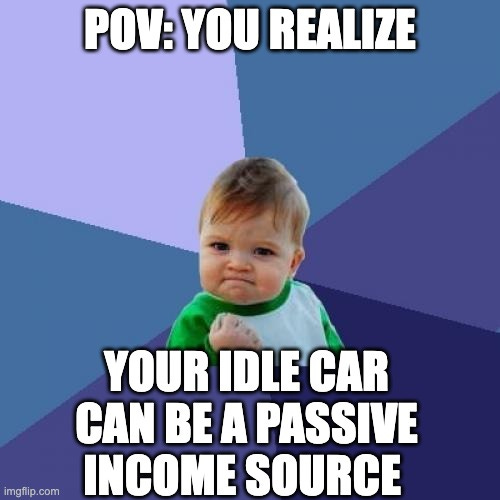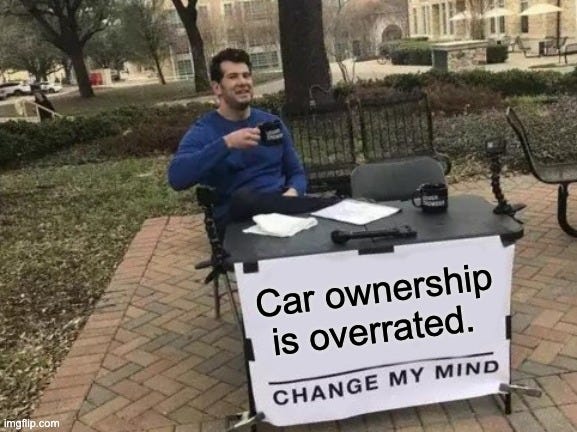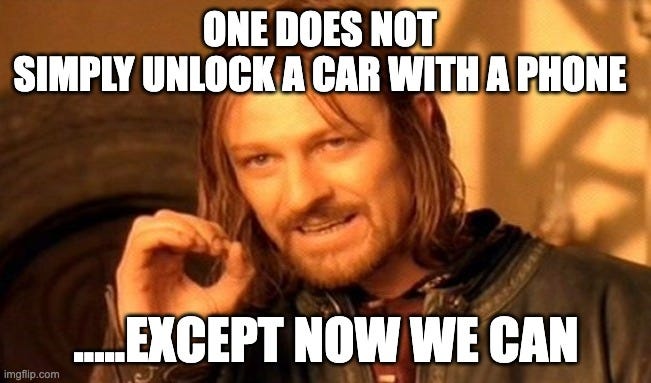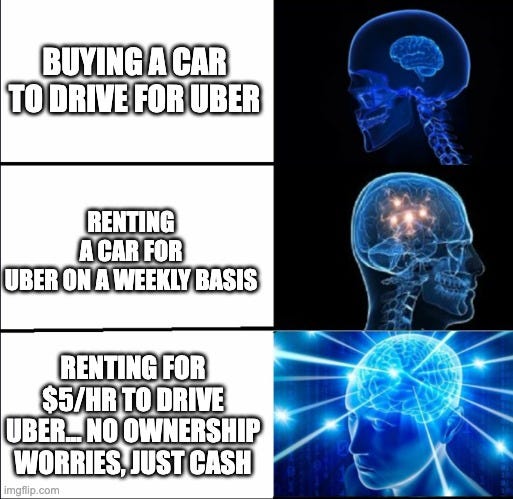🚗 On the Move: How Getaround Unlocked the Future of Car Sharing
How this trailblazer in peer-to-peer car sharing tackled trust, tech, and sustainability to scale globally and transform the future of transportation.
In 2009, renting a car meant endless paperwork, rigid timelines, and long waits- hardly fitting in a world becoming increasingly mobile-first. While smartphones were redefining convenience, the car rental industry lagged behind.
Enter Getaround, a company that didn’t just disrupt the rental industry- it reimagined how we think about cars altogether. But this wasn’t just about filling a market gap.
Solving for trust, navigating insurance complexities, and creating the tech infrastructure to make car-sharing effortless were all part of rewriting the rules of car-sharing.
Let’s dive into how Getaround became a trailblazer in shared mobility.
🧩 From Gap to Growth
With most cars sitting idle 95% of the time—30 billion hours wasted daily—Getaround saw an opportunity to turn these idle vehicles into income generators.
Instead of building and managing an expensive fleet, Getaround introduced a peer-to-peer model, enabling private car owners to rent out their vehicles. The result? A scalable, hyperlocal, and cost-effective service that addresses the shortcomings of traditional rentals.
For car owners: Extra income from idle vehicles
For renters: Access to cars for anything from quick errands to luxury trials
Users can filter their searches by vehicle type, size, transmission type, and special features (e.g., pet-friendly or equipped with bike racks) to find the perfect match for their needs.
Sustainability at the Core
From the start, Getaround positioned itself as more than a tech company—its “access over ownership” philosophy became a driving force for change in urban mobility. This approach aligns with broader efforts to reduce carbon footprints and ease urban congestion. Here’s how:
Maximizing vehicle utilization: By optimizing the use of existing cars, Getaround reduces the need for new ones, cutting down on manufacturing emissions (Studies show that shared mobility can reduce CO2 emissions by up to 40%).
Reducing urban congestion: Shared cars mean fewer vehicles clogging city streets.
Green mobility: Getaround is expanding its electric vehicle (EV) fleet, positioning itself as a leader in sustainable transportation.
Zeroing in on Urban Markets
It strategically focused on urban markets, where the demand for cars is high, but the challenges of ownership—such as purchasing, maintenance, and insurance—make it a hassle.
By offering a flexible, on-demand alternative, Getaround became an attractive option for city dwellers seeking to access vehicles for quick errands, weekend getaways, or even luxury experiences without the long-term financial commitment and the environmental footprint of unnecessary car ownership.
This model not only made car-sharing more affordable, but it also allowed users to save an average of $1,800 per year compared to owning a car.
👥 Winning Early Adopters
Getaround’s breakthrough moment came in 2011 at TechCrunch Disrupt, where it won the Startup Battlefield competition. This early visibility didn’t just attract press—it sparked interest from early adopters who appreciated:
Lower costs compared to traditional car rentals
Access to unique vehicles (Rent a Tesla for an hour, anyone?)
A sense of contributing to a more sustainable economy
This grassroots appeal quickly caught the eye of investors, helping Getaround raise a $10M Series A by 2012 and expand into new cities like Portland, Chicago, and Austin. The funds also fueled their referral program- when a referred friend lists their first car, the referrer earns a $200 bonus. Additionally, the referrer receives 25% of the referred host's earnings for the first 60 days after listing a vehicle.
This program sparked viral growth, accelerating the platform’s scale and attracting even more users who saw the value in a more efficient, flexible, and eco-friendly alternative to car ownership.
📜 Building a Regulatory Moat
Traditional insurance models weren’t designed for peer-to-peer car sharing, and disrupting this industry required overcoming significant regulatory hurdles. To address the liability concerns, Getaround's co-founder, Jessica Scorpio, led an initiative to pass legislation clarifying insurance requirements for car-sharing services.
This effort resulted in California's AB 1871 law, which defined how insurance should be structured for peer-to-peer car-sharing platforms. It mandated that car-sharing companies maintain specific levels of coverage during rentals, creating a safer environment for both car owners and renters.
This legislation also gave Getaround the credibility to secure partnerships with major insurers like Berkshire Hathaway, further legitimizing the platform and ensuring coverage for both parties.
More recently, Getaround has continued to innovate by integrating technology into its insurance model. Collaborations with companies like Axle now allow renters to use their car insurance while renting vehicles through Getaround, offering greater flexibility and potentially reducing costs by up to 15%.
👩💻 Tech That Builds Trust
Earlier car-sharing platforms faltered because they didn’t address the core frictions: trust and convenience.
A. Getaround Connect tackled this by allowing renters to unlock cars directly via their phones—eliminating the awkwardness of key exchanges or delays.
B. In partnership with TransUnion, Getaround developed TrustScore AI, which uses AI to analyze user behaviour, assess risk, and enhance pricing accuracy. By matching renters with trustworthy owners, it has reduced claims costs by up to 50%, making the business model more sustainable.
Getaround also integrates several additional features to build trust:
Verified profiles to ensure reliability for the renters as well as the owners.
Real-time damage checks before and after trips to provide transparency and protect both parties.
Automated dispute resolution tools to streamline conflict resolution, reducing the need for lengthy interactions.
🤝 Partnerships to Scale
Strategic collaborations have played a crucial role in Getaround's rapid expansion and increased credibility- helped solidify Getaround's position in both the gig economy and the broader car-sharing market, making their platform more accessible and appealing to users.
A. Uber: Democratizing the Gig Economy
First launched in SF in May 2017, Getaround’s rideshare-ready rentals provide Uber drivers with an affordable, convenient option to access “ride-share” ready cars on-demand that can be used for driving with Uber at just $5/hour.
Seamlessly integrating car-sharing with the ride-hailing ecosystem, Getaround not only provided a cost-effective solution but also addressed the growing demand for flexible mobility options.
We’ve seen rapid and consistent car-sharing adoption in each of these cities — that, in conjunction with Uber’s successes in those markets, and we knew these would be great expansion markets as we continue iterating and planning for future growth. - Greg Shay, Director of business development, Getaround
B. Toyota: A Technological Leap
Initiated in 2016, Getaround’s partnership with Toyota, the world’s largest automaker, began with its participation in Getaround’s $45 million Series C funding round. The collaboration aimed to combine their technological strengths to deliver a seamless and innovative car-sharing experience, benefiting both renters and car owners.
It combined Getaround’s connected car technology with Toyota's Mobility Service Platform and Bluetooth-enabled Smart Key Box, allowing renters to locate, access, and drive vehicles without a physical key.
New Toyota leaseholders could offset their monthly payments through rental income on Getaround, making ownership financially viable and encouraging participation in the car-sharing ecosystem.
Beyond technology, the partnership was rooted in a shared vision to promote sustainable urban living by tackling vehicle underutilization, traffic congestion, and CO2 emissions through expanded car-sharing in dense urban areas.
This collaboration also reflects a broader industry shift: as car ownership declines among younger generations, automakers are pivoting to mobility services to engage with consumers.
🛣️ The Road Ahead
In 2019, Getaround acquired Drivy, Europe’s leading car-sharing platform, significantly expanding its global footprint. By 2023, acquisitions like HyreCar’s assets enhanced its position in the gig economy, enabling operations in over 1,000 cities across eight countries, including the U.S., France, Spain, Germany, Austria, Belgium, Norway, and the UK.
That same year, Getaround went public, trading under GETR on the NYSE—solidifying its position as an industry leader and showcasing the scalability of the peer-to-peer model.
With the rise of electric vehicles (EVs) and a growing global focus on sustainable transportation, Getaround is well-positioned to capitalize on the shift toward greener mobility. The company’s expanding fleet of EVs, along with its efforts to integrate more smart technology into its platform, positions Getaround for success in the future of car-sharing within an eco-conscious world.
The future of mobility is not only connected—it’s shared.
Thanks for reading! 😄
One Step Ahead is a publication by Plotline. With this series, we plan to give you a behind-the-scenes breakdown of the product and growth strategies that have propelled consumer apps to where they are today.






